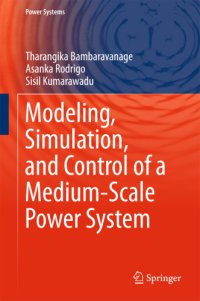
Ebook: Modeling, Simulation, and Control of a Medium-Scale Power System
- Tags: Réseaux électriques (Énergie)--Gestion, Réseaux électriques (Énergie)--Répartition des charges, Réseaux électriques (Énergie) -- Gestion, Réseaux électriques (Énergie) -- Répartition des charges
- Series: Power systems (En ligne)
- Year: 2018
- Publisher: Springer Singapore
- City: Singapore
- Language: English
- epub
""Acknowledgements""; ""Contents""; ""About the Authors""; ""List of Figures""; ""List of Tables""; ""Abstract""; ""1 Introduction""; ""2 Literature Survey""; ""2.1 Structure of an Electrical Power System""; ""2.2 Power System Stability""; ""2.3 Why Power System Instability Situations Occur?""; ""2.4 Disturbances""; ""2.4.1 Effects of the Disturbances on the Power System""; ""2.5 Reliability of a Power System""; ""2.6 Quality of a Power System""; ""2.6.1 Addressing Instability Situations Due to Perturbations in the Power System""; ""2.6.2 Classification of Power System Dynamics"";""5.2 Discussion: Load Shedding Scheme-II with Generation Deficit of 495.14Â MW""""5.2.1 Performance of the National Grid""; ""5.2.2 Performance of Island Rantembe""; ""5.2.3 Performance of Island Matugama""; ""5.2.4 Performance of Island Embilipitiya""; ""5.2.5 Performance of Island Kiribathkumbura""; ""5.3 Performance Comparison on Selected Load Shedding Schemes (LSS)""; ""6 Conclusion""; ""Appendices""; ""Appendix A: Transmission Lines""; ""Appendix B: Composite Loads""; ""Appendix C: Generation Characteristic""; ""Appendix D"";""3.3.1 LS Logic1 Control System Module""""3.3.2 U_Frequency Control System Module""; ""3.3.3 Add_Ld Control System Module""; ""3.4 Verifying the Simulation Model Performance""; ""3.4.1 Steady State Operation""; ""3.4.2 Generator Tripping/Sudden Generation Deficit Situation""; ""4 Designing the Load Shedding Scheme""; ""4.1 Overview of the Power System of Sri Lanka""; ""4.2 Identification of Parameters""; ""4.2.1 Power System Regulations and Practice of Sri Lanka""; ""4.2.2 Identifying Settling Frequency""; ""4.2.3 Deciding the Number of Steps in the Load Shedding Scheme"";""4.2.4 First Step of Load Shedding Scheme""""4.2.5 Identifying When to Implement Load Shedding Based on Rate of Change of Frequency (ROCOF)""; ""4.2.6 Delay Time""; ""4.3 Ahsansâ#x80; #x99; Scheme as a Pilot Model [56]""; ""4.4 Proposed Methodology""; ""4.4.1 Load Shedding Scheme-I (Based on Prevailing Facilities Available with the CEB)""; ""4.4.2 Load Shedding Scheme-II (Based on Disintegration of the Power System)""; ""5 Results and Discussion""; ""5.1 Discussion: Load Shedding Scheme-I with Generation Deficit of 829.6Â MW"";This book highlights the most important aspects of mathematical modeling, computer simulation, and control of medium-scale power systems. It discusses a number of practical examples based on Sri Lanka's power system, one characterized by comparatively high degrees of variability and uncertainty. Recently introduced concepts such as controlled disintegration to maintain grid stability are discussed and studied using simulations of practical scenarios. Power systems are complex, geographically distributed, dynamical systems with numerous interconnections between neighboring systems. Further, they often comprise a generation mix that includes hydro, thermal, combined cycle, and intermittent renewable plants, as well as considerably extended transmission lines. Hence, the detailed analysis of their transient behaviors in the presence of disturbances is both highly theory-intensive and challenging in practice. Effectively regulating and controlling power system behavior to ensure consistent service quality and transient stability requires the use of various schemes and systems. The book's initial chapters detail the fundamentals of power systems; in turn, system modeling and simulation results using Power Systems Computer Aided Design/Electromagnetic Transients including DC (PSCAD/EMTDC) software are presented and compared with available real-world data. Lastly, the book uses computer simulation studies under a variety of practical contingency scenarios to compare several under-frequency load-shedding schemes. Given the breadth and depth of its coverage, it offers a truly unique resource on the management of medium-scale power systems.;""2.7 Process for Generation-Load Balance""""2.7.1 Primary Control (Is by Governors)""; ""2.7.2 Secondary Control (Is by Automatic Generation Controls)""; ""2.7.3 Tertiary Control""; ""2.7.4 Time Control""; ""2.8 Under-Frequency Load Shedding""; ""3 Modelling the Power System""; ""3.1 Power System Components""; ""3.2 Configuring Power System Components/Mathematical Modeling""; ""3.2.1 Transmission Lines""; ""3.2.2 Under-Ground Cables""; ""3.2.3 Transformers""; ""3.2.4 Generators""; ""3.2.5 Exciters""; ""3.2.6 Turbines""; ""3.2.7 Governors""; ""3.3 Control System of the Overall Power System""
Download the book Modeling, Simulation, and Control of a Medium-Scale Power System for free or read online
Continue reading on any device:

Last viewed books
Related books
{related-news}
Comments (0)